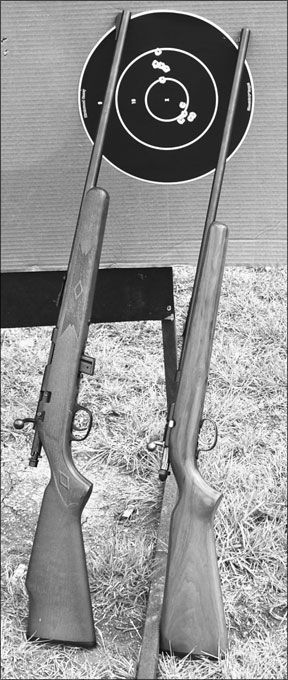Getting a greenhorn shooter to take that first step along the path of a seasoned shooter, whether the targets are at the shooting range or running around in a field, often starts with a 22-caliber rifle. Most of us old-timers have fond memories of our first 22-caliber rifle. Bringing home a mess or rabbits or squirrels; punching holes in tin cans; or just trying to shoot the smallest group on paper were all part of our marksmanship learning experience.
Some of us remember that the first scene of the Audie Murphy biographical movie To Hell and Back depicts a young Murphy using a single shot to bag a rabbit for his family dinner. Developing his shooting skills with a 22-caliber rifle proved to be very beneficial marksmanship training for the man who would become the most decorated U.S. solider of World War II.

With a goal of getting our hands on a couple of used rimfires that could fit the requirements for a beginner’s rifle, we checked out the used gun rack at Dury’s Gun Shop (www.durysguns.com) and came up with a Remington Model 514 and a Marlin Model 25N, both with price tags of $200.
Although the Remington is a single shot and the Marlin has a seven-round detachable magazine, both rifles feature a basic bolt action loading access to the chamber; both have open sights; and both have been around long enough to have a few fans in the rimfire club.
The Model 514 was introduced in 1948 and was discontinued in 1970, while the Model 25N is a much newer 22-caliber rifle that was introduced in 1989, and was later renamed the Model 925. Remington acquired the Marlin operation in 2007 and continues to manufacture various models of 22-caliber rifles. However, our interest was in “experienced” versions of a beginner’s shooting tool and the two veteran models that would most likely be older than the beginning shooter seemed to be an appropriate match.
To maintain a level playing field, we utilized the open sights featured on both rifles, rather than install better optics preferred by veteran marksmen whose eyesight may not be as good as younger shooters.
To examine the shooting performance of the two 22-caliber rifles, we selected a variety of 22-caliber Long Rifle ammunition. Although the Remington is designed to handle Shorts, Longs, and Long Rifles, we limited our ammunition choices to Long Rifle loads in fairness to the Marlin. Our test ammunition included CCI Standard Velocity; Eley Super Silhouex; and Aguila Super SE Extra, all 40-grain solid bullets; and Punta Hueca 39-grain hollowpoints made in Argentina. The average muzzle velocity of each of the rounds is 1200 fps. Targets used in our test were the Birchwood Casey Shoot-N-C bull’s eyes at 25 yards, with all shots taken from a solid bench rest.
Here’s our test report:
Remington Model 514 22 LR, $200
We would be hard pressed to find a more basic .22-caliber rifle than this plain shooting tool —no frills, no bling, just a simple device for sending bullets downrange. That is not a bad thing, particularly if the rifle performs well on the range.
Our first impression was that the Remington might be a little light for quality range time. The Model 514 tips the scale at just 4.5 pounds, although the 24.75-inch barrel provided a more stable shooting platform than we expected.
The drop at the comb was 1.5 inches and the drop at the heel was 2.25 inches, with a length of pull of 13.5 inches and an overall length of 41.75 inches. The larger members of our test team were able to adjust to the dimensions, which would be appropriate for a younger or smaller shooter. The trigger pull of 4.5 pounds was just a little heavier than we would have liked—a trip to the gunsmith for an adjustment would be recommended.
A trip to the target range is where the Remington really shined, producing our test’s smallest five-shot group of 0.5 inch at 25 yards with the CCI Standard Velocity ammunition. As with most rifles, one type of ammunition often produces the best results, and a shooter should be willing to spend some experiment time to find the right load for their shooting tool.
We were able to easily align the front and rear sight on the targets with the Remington’s open sights and experienced no function problems except with the Punta Hueca ammunition. Several of the spent rounds had to be pried out of the chamber.
The Remington also produced its largest groups with the Punta Hueca bullets. Our conclusion, based on similar functioning problems with the ammunition in the Marlin tests, is that we just wouldn’t use that type of bullets in our single-shot rifle.
We liked the balance and feel of the longer barrel on the Remington, which also may have been a factor in its accuracy on the range. The groups shot with the Remington were (with one exception) consistently smaller than the same groups shot with the Marlin. In the accuracy race, the Remington finished first.
Because of the plain wood and finish on the Remington, the rifle is ideally suited for adjustments in stock dimensions, refinishing and other customizing to make the beginner’s first rifle a personalized tool and one that he or she would be proud to make a permanent addition to their firearm collection.
Marlin Model 25N 22 LR, $200
This is a meatier version of the typical 22-caliber rifle often brought into play as a beginner’s shooting tool, and we liked the heft and balance of this model. For a person interested in teaching a beginning shooter how to handle both a small-caliber rifle with large-caliber dimensions, the Marlin is a fine choice.
Although the Marlin utilizes a seven-round detachable magazine, we limited most of our testing to single-shot applications. The times we fed seven rounds into the magazine and fired them through the rifle, the Marlin performed flawlessly. This would be a plus for someone interested in a repeater, rather than a single shot.
This rifle weighed 6.1 pounds, with a 22-inch barrel and a pistol grip stock. The drop at the comb and the drop at the heel of the Monte Carlo stock were both 1.5 inches, and the length of pull was the same as the Remington at 13.5 inches. As with the Remington, we would recommend a trip to the gunsmith for a trigger-pull adjustment, as the Marlin touched off at exactly 5 pounds. A lighter trigger of about 3 pounds would increase the accuracy of the rifle, which is particularly important with a small caliber like a 22 LR.
The open sights of the Marlin were functional, and we were pleased that the rear sight was adjustable for both windage and elevation through a little screwdriver work. Putting bullets on the target was no problem.
However, we were disappointed in the accuracy of the Marlin and had expected the heavier rifle to produce better five-shot groups with the variety of ammunition.
Surprisingly, the best groups were achieved using the Punte Hueca ammunition, with the Marlin producing its smallest group of 0.75 inch with the low-end hollowpoints. As with the Remington, we did experience problems ejecting the spent Punte Hueca rounds from the chamber and had to pry several of them free with a knife blade.
Tipping the scales at just over 6 pounds, we think the Marlin might be a little heavy for a young shooter of slight build and is not quite as easy to handle as the Remington. As noted earlier, the plus side to the extra weight is that the Marlin would provide very good service as a practice rifle for getting a youngster accustomed to centerfire firearms.






























I have a Remington model 514 22cal. Rifle. This rifle has no serial number. This makes me think that it is an older model. It is in very good condition. I like it very much. But I have to replace the lever on the bolt because my lever is broken off can you recommend a place to look for one? I am blueing the rifle now and have inspected it and everything looks good. I am going to target shoot it and test the accuracy. I may wish to sell this gun. But because of its condition and age it will not be cheap. If you are interested in buying it contact me at Robert.stewart103@icloud.com . Thank you